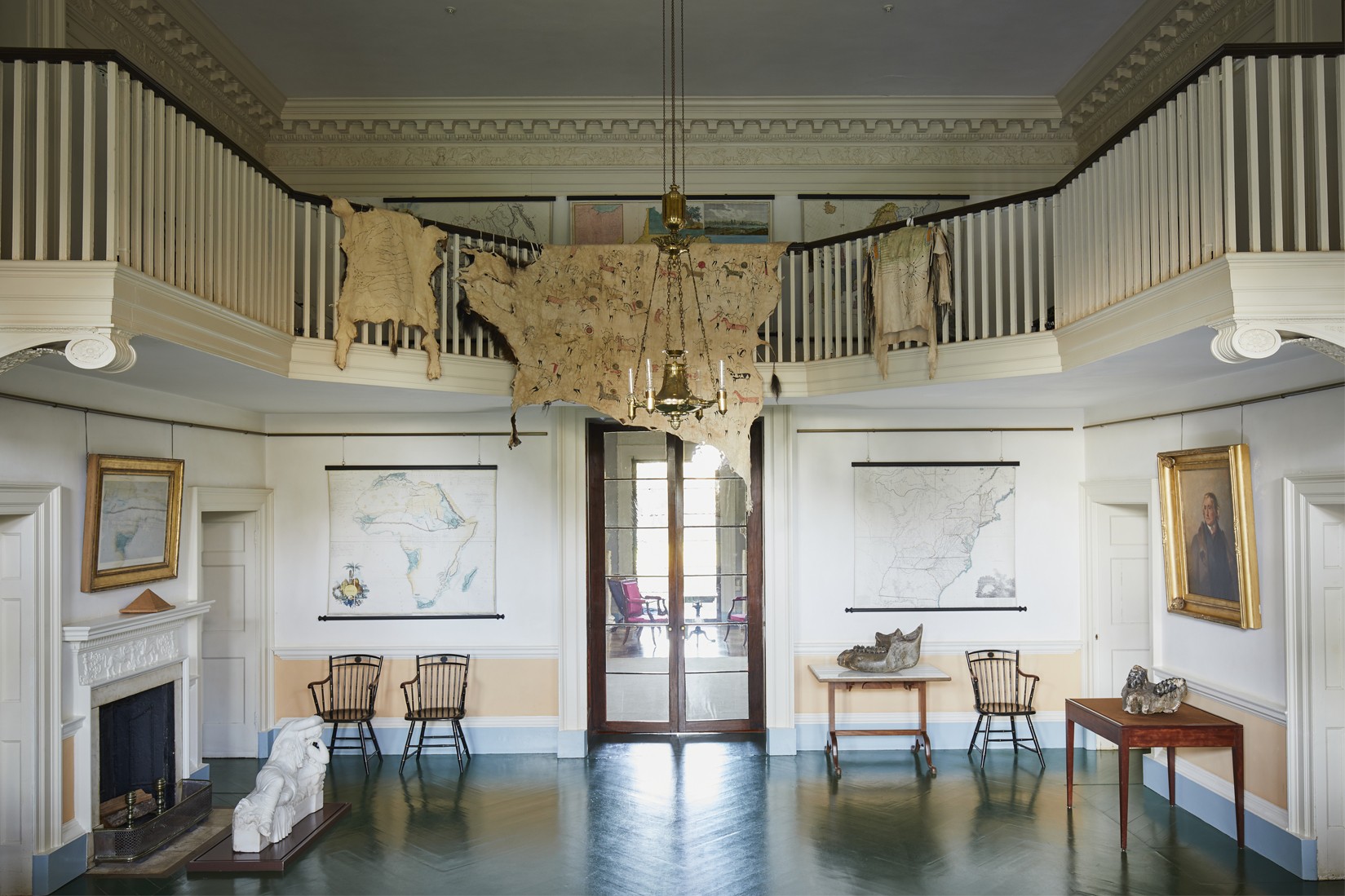Hall
Dimensions: 27' 11" × 23' 9"; ceiling 18' 2"
Order: Ionic with modillions
Source: Palladio, with frieze ornaments from the Temple of Antoninus and Faustina, from Desgodetz, Les Édifices Antiques de Rome
Color: Whitewash, with a yellow-orange dado (the portion of the wall below the chair-rail); green floorcloth
Architectural Features: Balcony connects two mezzanine-level wings; green floorcloth; ceiling features plaster eagle and stars pattern (see below)
Furnishings of Note: Great Clock with case designed by Jefferson. Art on display included eleven copies of Old Masters paintings, as well as busts of prominent figures such as Alexander Hamilton and Voltaire. The Declaration of Independence was celebrated with the display of two engravings, one showing John Trumbull's famous depiction of the signing, and the other John Binn's embellished print of the text. Indian artifacts numbered at least forty, including pipes, clothing, domestic objects, and a Mandan buffalo robe depicting a battle scene. The room held natural history specimens such as antlers and bones, as well as maps, such as one of Virginia as surveyed by Jefferson's father, Peter Jefferson, and Joshua Fry. To accommodate many visitors, the room contained up to twenty-eight chairs.
-Bryan Craig, 2/20/2007, updated 2009
Objects on Display in this Room
Mapa Geográfico De América Meridional (1799)
Declaration of Independence by Trumbull (Engraving)
Map of the United States of North America (1802)
Saint Jerome in Meditation (Painting)
Jesus in the Praetorium (Painting)
Young Chief of Sack Nation (Painting)
Primary Source References
1808 March 18. (Ellen Wayles Randolph Coolidge to Jefferson). "Papa has been to Monticello[.] he says the hall is very beautifull now that it is done."[1]
1809. (George R. Gilmer). "Three rooms of his house were left open, to be shown to strangers who might visit the place. I saw there statuary, fine paintings, and a collection of Indian works. The statuary was very beautiful: I could not be satisfied with looking at it. The paintings did not at all equal the expectations which my scholastic reading had excited. The Indian remains were singular things."[2]
1815 February 7. (George Ticknor). "You enter, by a glass folding-door, into a hall which reminds you of Fielding's 'Man of the Mountain,' by the strange furniture of its walls. On one side hang the head and horns of an elk, a deer, and a buffalo; another is covered with curiosities which Lewis and Clarke found in their wild and perilous expedition. On the third, among many other striking matters, was the head of a mammoth, or, as Cuvier calls it, a mastodon .... On the fourth side, in odd union with a fine painting of the Repentance of Saint Peter, is an Indian map on leather, of the southern waters of the Missouri, and an Indian representation of a bloody battle, handed down in their tradition. Through this hall—or rather museum—we passed to the dining-room ...."[3]
1818 May 16. (Salma Hale to Arthur Livermore). "His house is filled with paintings and Indian relics, and a view of his rooms affords as much gratification as of a museum."[4]
1823-1824. (Jane Blair Smith). "... the lofty hall of entrance with its Indian trophies—its gallery decorated with enormous antlers—its walls covered with relics from all lands ... was today relieved of its somber aspect: a sleeping statue of Ariadne had been removed to another part of the hall: a fireplace had been revealed in which burned a cheery wood-fire, produced a somewhat incongruous effect, for projecting over the mantel was a model of the Pyramid of Cheops, the base so contrived as to contain a portion of the sand & pebble of the desert!"[5]
Further Sources
- Chew, Elizabeth. "Recreating the Indian Hall."
- Stein, Susan R. The Worlds of Thomas Jefferson at Monticello. New York: Harry N. Abrams, in association with the Thomas Jefferson Foundation, 1993.
- Look for further sources in the Thomas Jefferson Portal.
References
- ^ Family Letters, 335-36. Transcription available at Founders Online.
- ^ George R. Gilmer, Sketches of Some of the First Settlers of Upper Georgia, of the Cherokees, and the Author (New York: D. Appleton and Co., 1855), 242.
- ^ George Ticknor to Elisha Ticknor, February 7, 1815, in Life, Letters and Journals of George Ticknor (Boston: James R. Osgood and Co., 1876), 1:34, quoted in Peterson, Visitors, 62.
- ^ Proceedings of the Massachusetts Historical Society vol. XLVI (Boston: The Society, 1913): 404.
- ^ Jane Blair Smith, "The Carys of Virginia," Special Collections, University of Virginia Library.
